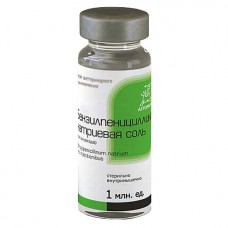Expiration date: 01/2026
Benzylpenicillin sodium salt is an antibacterial drug for animals. It is a white, fine-crystalline powder with a bitter taste, slightly hygroscopic. It is easily destroyed by acids, alkalis, alcohols, oxidizing agents, sunlight, gastric juice, when heated in aqueous solutions, and also when exposed to penicillinase. It is easily soluble in alcohol, water and saline.
STRUCTURE
The drug is obtained by biosynthesis from the life product of the mold fungus-Penicillium chrysogenum.
PHARMACOLOGICAL PROPERTIES
The antibacterial effect of penicillin is based on the inhibition of the synthesis of the polymer mucopeptide, which is part of the cell wall of microbes. Penicillin dramatically disrupts the metabolic processes of microorganisms sensitive to it. Depending on the concentration in the blood, its action can be bacteriostatic or bactericidal, the bactericidal concentrations are usually 2 to 4 times higher than the bacteriostatic ones. Penicillin has a high antibiotic activity mainly against Gram-positive microorganisms (streptococci, pneumococci, staphylococci, diphtheria and anthrax bacilli, Clostridium), Gram-negative cocci (gonococci, meningococci), spirochetes (treponemus, leptospira are less sensitive) and some pathogenic fungi (Actinomyces bovis). Resistant to the action of penicillin, as a rule, are gram-negative microbes (Klebsiella, brucella), rickettsia, viruses, protozoa and almost all fungi. Staphylococcus strains that form the enzyme penicillinase are resistant to the action of benzylpenicillin. The low activity of benzylpenicillin against bacteria of the intestinal group, Pseudomonas aeruginosa and other microorganisms is also associated with the production of penicillinase. Penicillin is easily absorbed and penetrates most of the body's tissues and fluids.
With parenteral administration, it is rapidly absorbed into the blood and other tissues, poorly penetrates through the synovial membranes and the blood-brain barrier. After intramuscular administration of the sodium salt of benzylpenicillin, its concentration in the blood reaches a maximum within 30 minutes. After 6 to 8 hours after a single injection into the muscle, only traces of the antibiotic are found in the body, and to maintain the concentration at a sufficiently high therapeutic level, the administration should be repeated. With intravenous administration, the concentration of penicillin in the blood decreases rapidly. After absorption into the blood, penicillin is distributed unevenly in the body, although it penetrates almost all tissues, with the exception of the nervous and bone marrow. The antibiotic penetrates relatively weakly into various body cavities, with the exception of the peritoneal cavity. In the pleural cavity, pericardium and synovial bags, penicillin penetrates slowly and in small amounts, easily penetrates the placenta. Unlike sulfonamides, penicillin penetrates into fibrous tissues, providing a good therapeutic effect in pathological processes accompanied by inflammation and tissue necrosis. The effectiveness of penicillin in the focus of inflammation depends on the degree of vascularization. The diffusion of penicillin into the purulent effusion in abscesses and empyemas is insignificant. The liver and kidneys concentrate penicillin in the bile and urine. 90% of the dose administered parenterally is excreted in the urine. Minor amounts are excreted with saliva, sweat, milk, and bile. Usually, with parenteral use, the release of penicillin begins 10 to 20 minutes after administration; after 8 hours, up to 90% of the drug is excreted from the body.
INDICATIONS
It is prescribed for diseases caused by microorganisms sensitive to benzylpenicillin, including anthrax, necrobacteriosis, pasteurellosis, pneumonia, mastitis, endometritis, wound infections, otitis, septicemia, phlegmon, urogenital tract infections, actinomycosis, emcar, horse soap, porcine erysipelas, avian spirochetosis, as well as viral diseases in case of complications of bacterial infection.an infection.
APPLICATION
Benzylpenicillin sodium salt is mainly administered intramuscularly. A solution of penicillin salt is prepared on water for injection immediately before administration, without heating, following the rules of asepsis, usually at the rate of 100,000 units per 1 ml. Prepared solutions for injection should be used immediately; it is allowed to store them for no more than 1-2 days in a dark place at room temperature and subject to complete asepsis. Often, to prolong the action of benzylpenicillin, a 0.5% solution of novocaine is used as a solvent, which is administered intramuscularly every 6 hours, but not less than 3 times a day. Due to the fact that novocaine promotes allergy, it should be avoided in some cases.
To maintain the necessary constantly high concentration in the blood, penicillin is administered intramuscularly 4 to 6 times a day.
The course of treatment is not less than 4-7 days, in severe forms of the disease 7-10 days or more. A solution of benzylpenicillin sodium salt can be administered intravenously (in severe septic conditions). In this method, the dose of the antibiotic is 2 times less than recommended for intramuscular administration. It is also used subcutaneously and in the form of powders on wound surfaces. If necessary, you can use aerosol.
Treatment with benzylpenicillin, as a rule, begins with the appointment of the first dose, larger than the subsequent ones, in order to create an effective concentration in the body, the level of which is maintained by the subsequent administration of smaller doses. To avoid the development of resistance of microorganisms to penicillin, effective doses should be used from the very beginning of treatment. It should also be borne in mind that early termination of treatment also leads to the appearance of resistant strains of pathogens.
Benzylpenicillin can be used in combination with streptomycin, sulfonamide preparations, specific serums and globulins. Complex therapy increases the effectiveness of drugs and prevents the development of resistant forms of bacteria, but may increase the possibility of side complications.
SPECIAL INSTRUCTIONS
If resistance of pathogens to benzylpenicillin is detected, it should be replaced with another antibiotic. Slaughter of animals for meat, which was used benzylpenicillin sodium salt, is allowed 3 days after the last administration of the drug. The meat of animals forcibly killed before the expiration of the specified period can be used for the production of meat and bone meal. Milk obtained during the treatment period should not be used for food purposes within 24 hours after stopping the administration of the drug. Such milk can be used for feeding animals.
CONTRAINDICATIONS
Hypersensitivity to penicillins.
SIDE EFFECTS
With intramuscular administration of the drug, sometimes there are rapidly developing allergic reactions (up to anaphylactic shock), which can pose a threat to the life of the animal. In this case, the animals are administered in the usual doses of one of the following drugs: norepinephrine or epinephrine subcutaneously, intramuscularly or intravenously, if necessary intracardially; 10% solution of calcium chloride intravenously; diphenhydramine intramuscularly or intravenously and other antihistamines, corticosteroids.
STORAGE
Store with caution in a dry, dark place, out of the reach of children and animals at a temperature of 5°C to 25°C. Shelf life — 3 years.
PACKAGING
The drug is produced packaged in 1 000 000 units. the active substance in glass vials.


